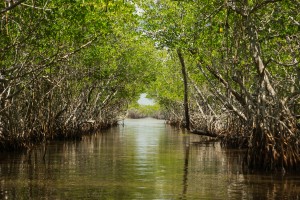 Have you ever seen a mangrove forest? They’re enchanting. Branches and roots all intertwined, lining waterways – they look like something out of a fantasy. Across the entire state of Florida, there are 469,000 acres of mangrove forests.
Have you ever seen a mangrove forest? They’re enchanting. Branches and roots all intertwined, lining waterways – they look like something out of a fantasy. Across the entire state of Florida, there are 469,000 acres of mangrove forests.
All About Mangroves
There are around 50 different species of mangroves, and three species can be found in Florida. The Everglades also happens to house the largest mangrove forest in North America. The forests can only thrive in tropical and subtropical climates, which is why they’re so abundant and native to southern Florida. These trees produce seeds that drop to the ground and get carried away by water or winds, and the seeds can pretty much grow wherever they land.
Types of Mangroves
Florida is home to three species of mangroves: the red mangrove, the black mangrove, and the white mangrove.
The most well-known, and easily seen in the Everglades, is the red mangrove. It’s a salt-tolerant tree that grows in areas with low-oxygen soil. They can take freshwater from the saltwater to survive. These mangroves have prop roots that make them look like they’re standing on the water. With these roots, the forests can handle rising tides in-and-out of the Everglades. The roots are reddish in color.
The black mangrove sits at a higher elevation than the red mangrove. This mangrove has finger-like projections that protrude from the soil around the trunk of the tree.
The white mangrove can be found at the highest elevations of these three species. This mangrove’s roots do not show; it has light, yellow-green leaves.
Benefits of Mangroves to the Ecosystem
The Florida coastline and the Everglades benefit from mangroves. They stabilize the coastline and higher lands by reducing erosion with their roots. The mangroves block winds, waves, floods, tides, and storm surges from damaging the land. The bigger, wider, and thicker a mangrove forest, the more protection to the environment it can provide. These mangroves can also filter water and keep water quality high. When leaves and other parts of the mangroves fall into the water below, it is decomposed by bacteria and protozoans, breaking it down into organic compounds, minerals, carbon dioxide, and nitrogenous wastes, which benefits the entire ecosystem.
Not only do they help the environment, mangroves also provide a habitat for a variety of birds and marine life. Many fish and animals use the forests as protection, shelter, or a place to find food.
Protecting Mangroves
According to American Forests, the oldest national conservation organization in the country, almost half of the world’s old-growth mangrove forest have disappeared in the past 50 years. They said the world continues to lose 578 square miles of mangroves per year. Humans are a major cause to the loss of the mangrove forests. Industrial shrimp farming and coastal development are the big contributors to the number of trees dwindling.
In Florida, protected areas have thriving mangrove forests. State and city laws have been established to protect these plants, which are a key role in Florida’s ecosystem. But it isn’t just humans, climate change has impacted the mangroves’ environment with rising temperatures and water levels.
Cruise Through the Mangroves
Do you want to see these Florida natives up close? There’s plenty of them to see in the Everglades, and a ride in an airboat can take you all around them. To schedule your airboat tour, call Captain Mitch’s Everglades Airboat Tours at 239-695-3377.






